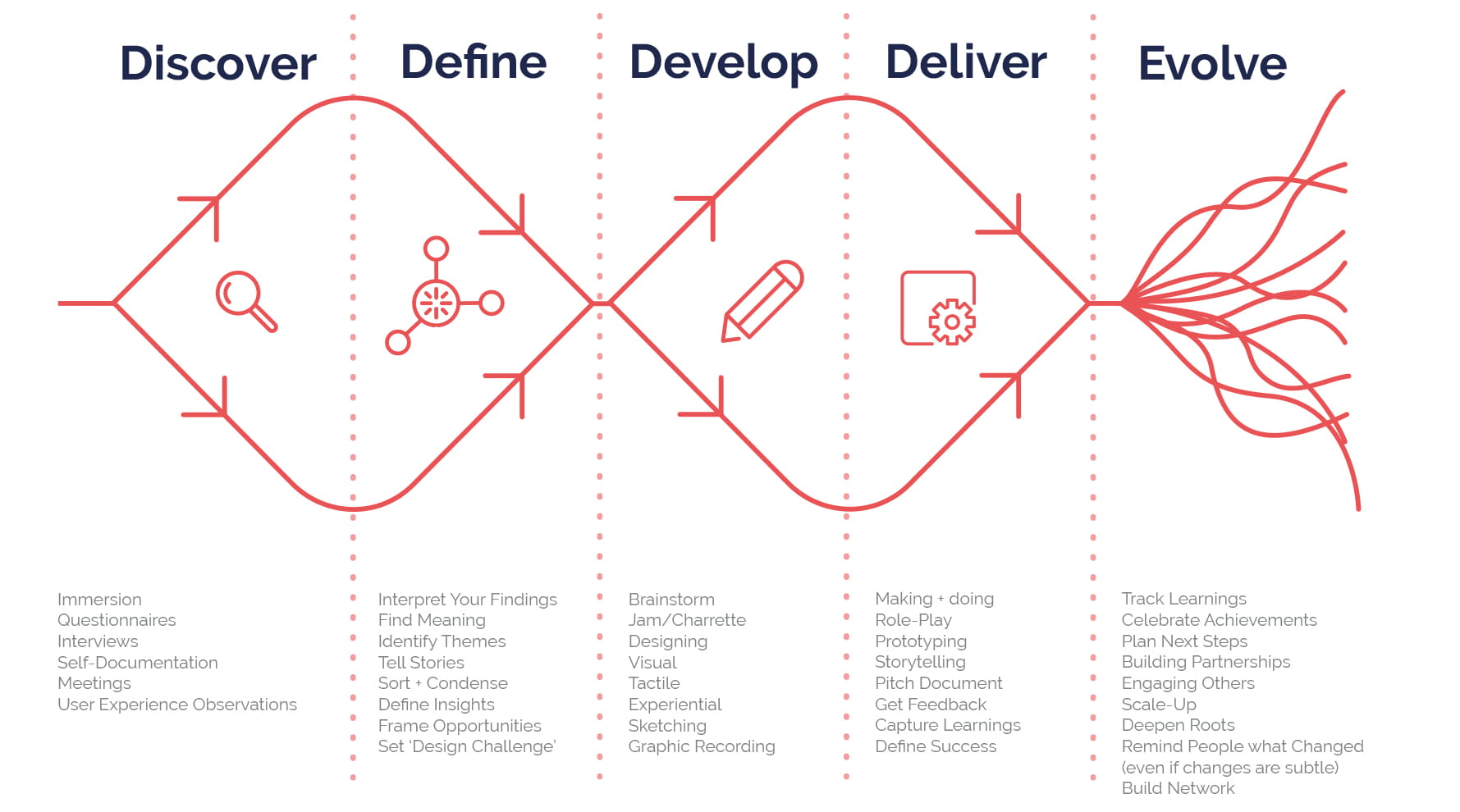Welcome to the next part of our ‘What the hell is?’ series, where we demystify jargon, explain its impact to your organisation and give you five insights that can help you change what you do today.
In this article we take a look at Human Centred Design (or HCD) – one of a raft of CX-related terms that can often create confusion, where we all seek clarity.
Firstly, what is human centred design?
Put simply, Human Centred Design (HCD) is a framework that puts the ‘human’ firmly at the centre of the problem-solving process when designing products or services.
HCD principles are used in fields like customer experience, user experience & service design. And while there are a multitude of confusing and overlapping terms that get thrown around in the HCD space, when you get down to it, it’s fundamentally about understanding people – their needs, constraints, contexts, behaviors, and wants – in order to build empathy and make sure that we design solutions to cater to the people they will impact the most.
When we talk about ‘design’ in this way, we’re not talking about styling or aesthetics. There’s no Photoshop here. Instead, ‘design’ in HCD is the methodology used to capture human needs, and define solutions, processes and outcomes that are ‘designed’ to meet those needs.
Also, ‘Humans’ in the context of HCD aren’t necessarily just the user of a product or service. HCD can also include the other people involved in a project such as employees and stakeholders.
So what does a HCD approach look like?
There are several frameworks that can be used to plan a Human Centred Design process, but the one that we use at Yell is the double diamond:

The double diamond was created by the UK Design Council shows the common stages of the design process (discover, define, develop & deliver) with the addition of divergent and convergent thinking.
1. Discover
In the ‘discover’ section of the project, research and data gathering expands out to uncover as much information as possible about the humans whose problems you are looking to solve.
It’s important to talk to real people here to ensure that you aren’t just making assumptions based on your own biases. We’re looking to understand the possible underlying issues that are contributing to a problem, not just the surface ones.
2. Define
From there the ‘Define’ stage narrows the focus to zero-in on the areas that are going to make the biggest impact to the humans that will benefit from the project.
3. Develop
Following the definition of the problem to be solved and the creation of a brief, the search for a solution begins by again broadening the thinking. No idea is a bad idea as they say!
4. Deliver
At the deliver stage the possible solutions are prototyped and tested to discover which solution will deliver the greatest benefit.
At each stage, the needs of real humans are at the centre of everything and the objective is to understand the underlying needs and behaviors and the rationale behind them. This differs from traditional thinking, where the customer is just one of the factors that is taken into account in a development process and knowledge about their needs and behaviors comes from customer research (what the customer says), with no effort to understand the underlying motivation.
Why is human-centred design important?
The answer here is simple: Products and services designed with a human-centred approach tend to have a higher level of usability and experience a higher adoption rate.
They can also deliver solutions that wouldn’t have been created without using HCD and understanding the underlying reasons behind behaviour.
A good example of this is Loot – a UK-based standalone bank transaction account which caters to students.
Loot’s interactions with its customers are all designed to help them understand how they are spending money and how much paid work they need to undertake to achieve their financial goals, whether that’s a holiday with friends, a new car, or just being able to afford a large pizza at the end of the week.
Ollie Purdue, founder of Loot explains the human motivation for developing the offer:
“I was at University and just got fed up with the fact my bank app only told me what I had spent. I needed to know what I was going to spend as my problem was could I afford to do this? Not ‘if I do this you tell me tomorrow that I shouldn’t have.”
Rather than viewing a bank account as a series of debits and credits and reporting on those, as most traditional banks do, Loot developed a human centred solution with personal financial management tools at its core to help users understand how much they were likely to spend in the future and how much they therefore needed to work to save for their goals.
With a different set of humans’ needs that were being catered to, Loot’s solution would have looked very different. But the result of focusing on the specific needs of real, specific humans, in this case students who work part-time and have short-term financial goals, meant that Loot was able to build exactly what its customers needed.
Top five things to know about Human Centered Design
1. To be truly effective, HCD must be driven by a customer and design-led culture. It tends to be used mainly in customer experience, user experience, service and product design, but it can be used across your organisation to design and create and more effective employee experience.
2. Human needs are identified through observation. This is why qualitative research is essential in ensuring that what you are creating actually helps real people. Talk to real people, seek to understand them. This is important!
3. Great HCD comes from considering both cognitive and emotional needs. As we encounter situations, we understand and perceive things differently, so while we may share a functional, rational need, it’s overlaid by our emotive state – which is essential to delivering solutions that meet human needs.
4. HCD should focus on delivering real outcomes for your humans. Looking good and delivering a business outcome is not enough. If you don’t design to deliver on a specific outcome, it’s not good design.
5. Your first solution to a problem is rarely the right one. Design should be iterative, based on feedback and focused on continuous improvement. You may also want to consider that your solution may be right for some people, but maybe not the ones you thought.
You can learn more and get started through this free course in HCD, provided by IDEO.
Alternatively, if you think your solution design process could do with adding more ‘human’ into it, then we’d love to have a chat about how you can do it. Email Nigel on nigel@yellcreative.com, or call him on 0488 614571.








